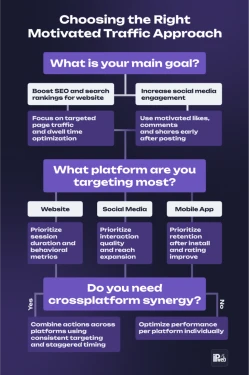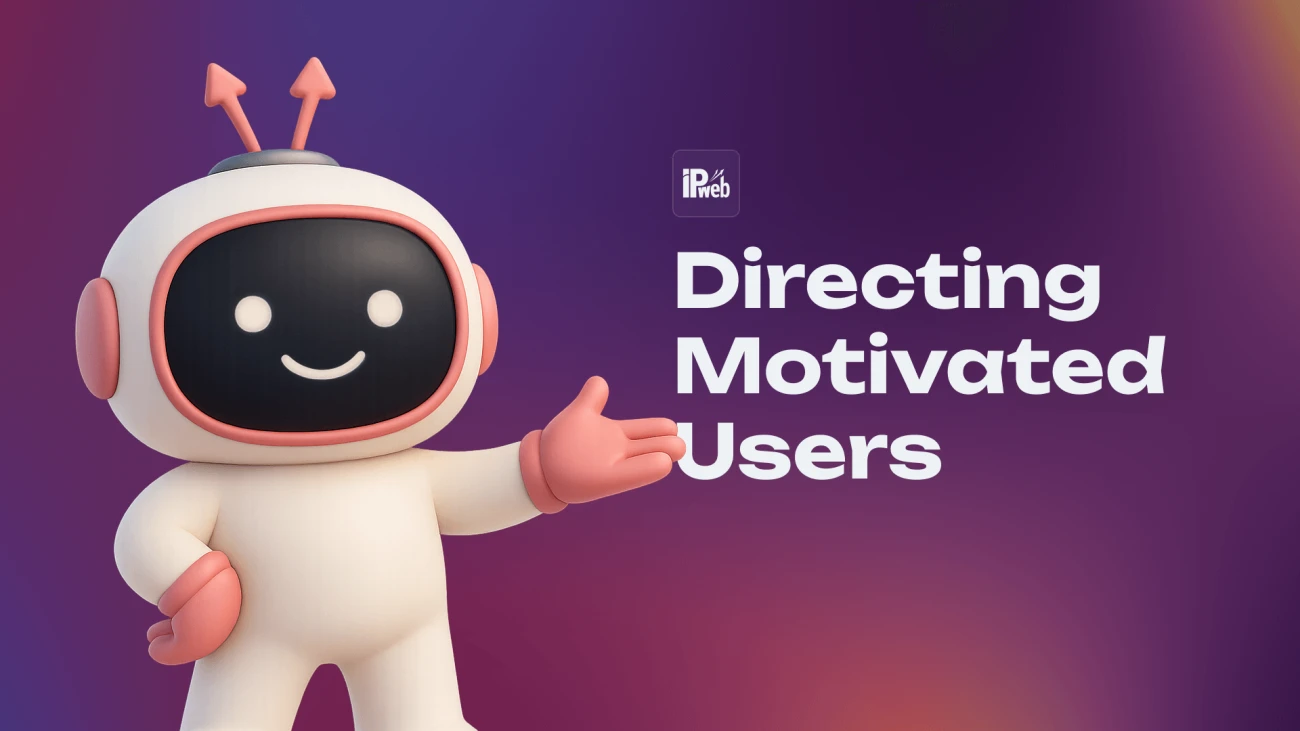In 2025, motivated traffic has become a critical asset for any serious digital marketing strategy. Whether you're aiming to boost search rankings, increase social media engagement, or drive app user acquisition, strategically directing motivated visitors can make all the difference.
But not all traffic behaves the same. Depending on the platform, audience expectations shift — and so should your tactics. Getting users to click on a website, interact with a post, or install an app requires a fine-tuned, platform-specific approach.
This guide will walk you through smart traffic strategies for websites, social media, and mobile apps. You’ll learn how to maximize your reach, optimize for performance, and avoid the pitfalls that could waste your budget or hurt your SEO. We'll also look at cost-effective solutions like IPweb's services that can deliver real engagement without compromising quality.
By mastering cross-platform promotion, you won’t just chase numbers — you’ll build loyal audiences, boost traffic conversion, and create sustainable growth across all digital fronts. Ready to unlock the full potential of your traffic efforts? Let’s dive in.
Understanding Motivated Traffic: Definition, Types, and Strategic Value
In digital marketing today, motivated traffic plays a crucial role in driving engagement, conversions, and visibility. Unlike random visitors, motivated users come to a platform with a specific incentive — whether it’s to claim a bonus, participate in an event, or complete a task for a reward. Their actions are purposeful, making them valuable for boosting metrics and platform signals.
There are different categories of incentivized traffic depending on the level of user engagement. High-quality motivated users not only visit but also interact — clicking, viewing content, or even completing micro-conversions. Lower-quality incentivized traffic might focus on single actions like simple page views, offering less impact on deeper engagement metrics.
Understanding these types is essential because different platforms respond differently to motivation cues.
- On websites, users driven by search intent — looking for answers or products — can positively influence search rankings.
- In social media, motivation often leans toward browsing behavior, making social media engagement tactics critical to hold attention.
- For apps, user behavior revolves around repeated usage and loyalty, tying directly into app user acquisition strategies and user retention efforts.
Choosing the right motivation strategy based on platform behavior patterns is key for sustainable digital growth.
Website Strategy: Leveraging Motivated Traffic for SEO Enhancement
Using motivated traffic smartly can be a game-changer for improving website SEO metrics. Unlike traditional visitors, motivated users can be guided to interact with specific parts of your site, enhancing behavioral signals that search engines monitor.
To truly boost search rankings, it’s not enough to drive traffic — you need to engineer user behavior. Focus first on dwell time optimization. Design content-rich pages where motivated visitors naturally spend more time, such as detailed articles, product comparisons, or interactive elements. A longer dwell time signals relevance to search algorithms.
Another key tactic is strategic page targeting. Instead of sending all incentivized traffic to your homepage, direct them to deeper pages: category hubs, blog posts, landing pages. This distributes engagement and improves the overall site structure strength in the eyes of Google.
Behavioral patterns matter too. Motivate users to click through multiple pages, use internal links, and interact with CTAs. Real browsing depth — not just single-page sessions — triggers positive algorithm signals.
Avoid outdated tricks like stuffing low-quality traffic onto random pages. Modern SEO-friendly traffic strategies must blend user interest with site goals, creating journeys that feel organic even when orchestrated. When done right, incentivized traffic helps your site climb the SERP ladder without raising red flags.
Social Media Amplification: Building Momentum with Motivated Engagement
Incentivized traffic isn’t just for websites. When used smartly, it can turbocharge your social media engagement and set the stage for viral organic growth. Most platforms — whether Instagram, TikTok, or YouTube — favor content that shows strong early activity. That’s why an initial burst of likes, comments, and shares can push posts into broader feeds, dramatically increasing organic reach.
Each platform requires a slightly different tactic. On Instagram, high early saves and comments matter more than simple likes. TikTok's algorithm rewards complete video views and replays, while YouTube values watch time and click-through rates. Tailoring your traffic strategies to these platform-specific signals ensures better results.
When directing motivated users, it’s critical to guide their behavior: encourage real engagement like comments or story views, not just passive likes. The goal isn’t to fake popularity — it’s to kickstart authentic interaction patterns that align with algorithm signals.
A smart strategy combines motivated actions with high-quality content that naturally sustains interest. Without valuable content, even the best initial traffic boost fades quickly. Mastering platform-specific tactics is key to ensuring incentivized traffic fuels real growth rather than disappearing into the void.
Done right, motivated engagement doesn't just inflate numbers — it creates a momentum loop that keeps building over time, strengthening your brand’s visibility across all major social networks.
App Growth Tactics: Using Motivated Traffic for Store Rankings and Retention
When it comes to app user acquisition, first impressions in the app stores matter more than ever. Incentivized traffic can give your app the early push it needs to climb the rankings. App stores like Google Play and Apple's App Store pay close attention to installation velocity, user retention, and initial engagement metrics within the first few days after launch.
By directing incentivized traffic toward your app, you can rapidly increase download numbers and signal positive algorithm responses. However, quality matters as much as quantity. If users install and instantly abandon the app, your search rankings can crash just as fast. That’s why balancing installation campaigns with basic engagement (opening the app, completing an onboarding step) is crucial.
Traffic strategies for apps must include:
- Targeted incentives: encouraging users to explore the app after installation.
- Funnel optimization: making sure users move past the first session smoothly.
- Behavioral patterns: designing a first-time user experience that hooks them.
- Monitoring platform analytics: tracking install-to-active ratios carefully.
Smart app marketers also use audience segmentation to refine targeting — bringing in users more likely to stay, rather than just chasing download counts. Remember: an install without retention has almost no value for long-term traffic conversion or monetization.
Done right, incentivized traffic can not only boost your visibility but also create a solid foundation for organic growth.
Cross-Platform Implementation: Creating a Unified Traffic Strategy
Running isolated campaigns on websites, apps, or social media no longer cuts it. If you want incentivized traffic to drive real results, you need a cross-platform approach that creates momentum across all user touchpoints. Effective traffic strategies focus on synchronizing efforts and building reinforcing loops between your web presence, social profiles, and apps.
First, it’s crucial to think about attribution models. Where did the user first engage? What action did they take next? Proper tracking ensures you know which channels spark interest — and which ones close the conversion. Using consistent audience targeting across platforms makes it easier to guide users through a planned journey.
Smart sequencing matters too:
- Initial awareness through social media engagement.
- Deeper interaction on your website with strong CTAs.
- Conversion via app installation or sign-up.
By coordinating your traffic sources, you increase user familiarity at every stage. Behavioral patterns show that when users encounter a brand on multiple platforms, their likelihood to engage rises significantly.
Also, keep an eye on platform analytics. Monitor how traffic moves between channels and adjust your conversion paths accordingly.
An effective cross-platform campaign builds:
- More powerful algorithm signals.
- Stronger brand credibility.
- Higher overall traffic conversion rates.
If you’re looking to streamline your traffic distribution across web, apps, and social media while maintaining maximum cost-efficiency, services like IPweb offer tailored solutions for multi-channel incentivized traffic setups.
Done right, cross-platform implementation turns motivated users into loyal audiences — no matter where they start their journey.
Measuring Success: Analytics and KPIs for Motivated Traffic Campaigns
Bringing in incentivized traffic is only the first step. The real magic happens when you measure the impact correctly — and optimize based on real data. Without proper tracking, even the best traffic strategies can turn into guesswork.
Every platform requires a slightly different set of performance indicators:
- Websites: Focus on engagement metrics like bounce rate, average session duration, and page depth. A rising search rankings position often signals that your incentivized traffic is sending positive algorithm signals.
- Social Media: Monitor initial social media engagement — likes, comments, shares — but also track secondary metrics like follower growth and post reach expansion.
- Apps: Measure install-to-activation rates, user retention over 7–30 days, and early monetization behaviors if applicable.
Comparative benchmarks matter too. For example:
- A bounce rate below 40% for motivated users on websites is excellent.
- A 20–25% 7-day retention rate for apps means strong user quality.
- On social platforms, a 3–5% engagement rate is considered healthy when using boosted traffic.
Distinguishing between motivated and organic performance gains requires careful use of attribution models and platform analytics. Track user journeys from first click to final action across all channels.
To calculate true ROI:
- Map out your full conversion paths (e.g., click → visit → action → purchase).
- Divide revenue attributed to motivated users by total campaign costs.
- Compare with organic ROI metrics to evaluate uplift.
Here’s a basic framework:
ROI (%) = (Revenue from Motivated Users – Campaign Costs) ÷ Campaign Costs × 100
Also, monitor long-term signals: Did incentivized traffic lead to more organic reach over time? Strong campaigns often create a "halo effect," lifting overall discovery and traffic monetization potential.
Measuring success isn't just about numbers — it's about spotting patterns, understanding audience behaviors, and fine-tuning for even better results.
|
|
|
|
|
|
|
|
|
|
|
|
|
|
|
|
|
|
|
|

FAQ
How can I make motivated traffic appear natural to platform algorithms?
Focus on engagement metrics like time on site, scroll depth, and interaction. Spread actions (clicks, likes, adds to favorites) over time. Avoid massive, instant spikes in behavioral patterns.
What's the ideal timing between motivated traffic campaigns across different platforms?
Allow a natural cooling-off period of 5–10 days between bursts. Algorithms prefer steady engagement curves over sudden, suspicious activity surges across websites, apps, or social media.
How do I transition from motivated to organic traffic effectively?
Use incentivized traffic as an initial push. Simultaneously invest in organic content strategies: SEO, influencer collaborations, and ads retargeting. Build authentic user behavior gradually to sustain momentum.
What safety measures should I take when implementing motivated traffic strategies?
Balance traffic distribution, monitor performance indicators (bounce rate, retention), avoid repetitive user actions, and work with reliable providers. Focus on maintaining natural-looking behavioral patterns across platforms.
Internet Marketer
